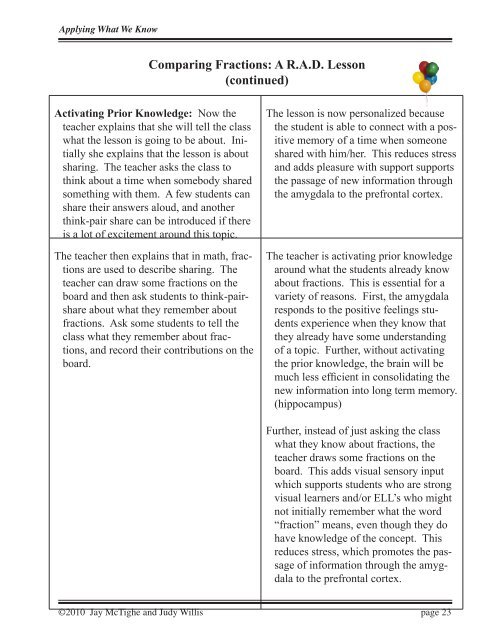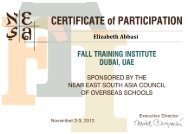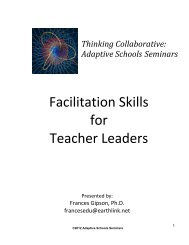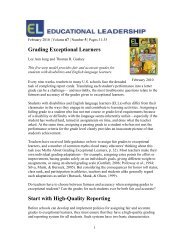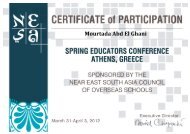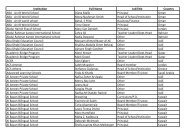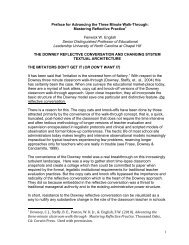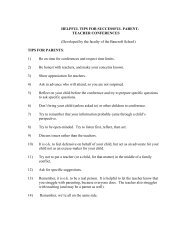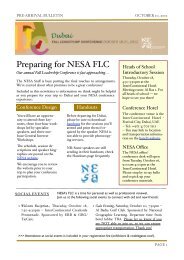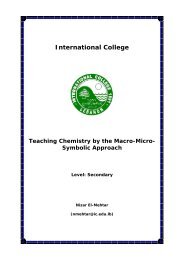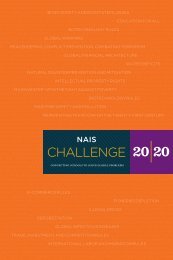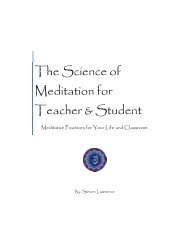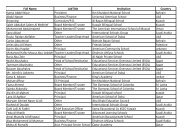Joint Presentation with Judy Willis - NESA
Joint Presentation with Judy Willis - NESA
Joint Presentation with Judy Willis - NESA
You also want an ePaper? Increase the reach of your titles
YUMPU automatically turns print PDFs into web optimized ePapers that Google loves.
Applying What We Know<br />
Comparing Fractions: A R.A.D. Lesson<br />
(continued)<br />
Activating Prior Knowledge: Now the<br />
teacher explains that she will tell the class<br />
what the lesson is going to be about. Initially<br />
she explains that the lesson is about<br />
sharing. The teacher asks the class to<br />
think about a time when somebody shared<br />
something <strong>with</strong> them. A few students can<br />
share their answers aloud, and another<br />
think-pair share can be introduced if there<br />
is a lot of excitement around this topic.<br />
The teacher then explains that in math, fractions<br />
are used to describe sharing. The<br />
teacher can draw some fractions on the<br />
board and then ask students to think-pairshare<br />
about what they remember about<br />
fractions. Ask some students to tell the<br />
class what they remember about fractions,<br />
and record their contributions on the<br />
board.<br />
The lesson is now personalized because<br />
the student is able to connect <strong>with</strong> a positive<br />
memory of a time when someone<br />
shared <strong>with</strong> him/her. This reduces stress<br />
and adds pleasure <strong>with</strong> support supports<br />
the passage of new information through<br />
the amygdala to the prefrontal cortex.<br />
The teacher is activating prior knowledge<br />
around what the students already know<br />
about fractions. This is essential for a<br />
variety of reasons. First, the amygdala<br />
responds to the positive feelings students<br />
experience when they know that<br />
they already have some understanding<br />
of a topic. Further, <strong>with</strong>out activating<br />
the prior knowledge, the brain will be<br />
much less efficient in consolidating the<br />
new information into long term memory.<br />
(hippocampus)<br />
Further, instead of just asking the class<br />
what they know about fractions, the<br />
teacher draws some fractions on the<br />
board. This adds visual sensory input<br />
which supports students who are strong<br />
visual learners and/or ELL’s who might<br />
not initially remember what the word<br />
“fraction” means, even though they do<br />
have knowledge of the concept. This<br />
reduces stress, which promotes the passage<br />
of information through the amygdala<br />
to the prefrontal cortex.<br />
©2010 Jay McTighe and <strong>Judy</strong> <strong>Willis</strong> page 23


